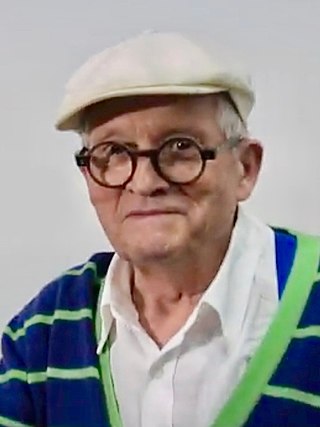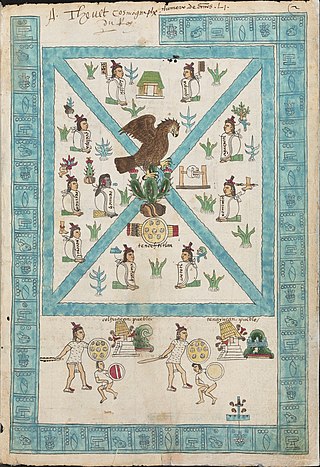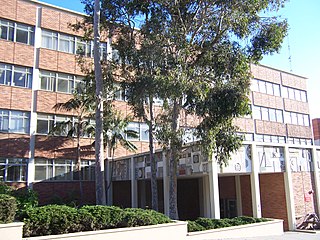
David Hockney is an English painter, draftsman, printmaker, stage designer, and photographer. As an important contributor to the pop art movement of the 1960s, he is considered one of the most influential British artists of the 20th century.

Catherine Sue Opie is an American fine-art photographer and educator. She lives and works in Los Angeles, as a professor of photography at University of California at Los Angeles.

The Codex Mendoza is an Aztec codex, believed to have been created around the year 1541. It contains a history of both the Aztec rulers and their conquests as well as a description of the daily life of pre-conquest Aztec society. The codex is written using traditional Aztec pictograms with a translation and explanation of the text provided in Spanish. It is named after Don Antonio de Mendoza (1495-1552), the viceroy of New Spain, who supervised its creation and who was a leading patron of native artists.

Eagle warriors or eagle knights were a special class of infantry soldier in the Aztec army, one of the two leading military special forces orders in Aztec society, the other being the Jaguar warriors. They were a type of Aztec warrior called a cuāuhocēlōtl. The word cuāuhocēlōtl derives from the eagle warrior cuāuhtli and the jaguar warrior ocēlōtl. These military orders were made up of the bravest soldiers of noble birth and those who had taken the greatest number of prisoners in battle. Of all of the Aztec warriors, they were the most feared. Eagle warriors, along with the jaguar warriors, were the only such classes which did not restrict access solely to the nobility, as commoners or, in Nahuatl, "mācēhualli" Nahuatl pronunciation:[maːseːwalːi] were occasionally admitted for special merit.

Aztec codices are Mesoamerican manuscripts made by the pre-Columbian Aztec, and their Nahuatl-speaking descendants during the colonial period in Mexico.
Alison Saar is a Los Angeles, California based sculptor, mixed-media, and installation artist. Her artwork focuses on the African diaspora and black female identity and is influenced by African, Caribbean, and Latin American folk art and spirituality. Saar is well known for "transforming found objects to reflect themes of cultural and social identity, history, and religion."
Mesoamerica, along with Mesopotamia and China, is one of three known places in the world where writing is thought to have developed independently. Mesoamerican scripts deciphered to date are a combination of logographic and syllabic systems. They are often called hieroglyphs due to the iconic shapes of many of the glyphs, a pattern superficially similar to Egyptian hieroglyphs. Fifteen distinct writing systems have been identified in pre-Columbian Mesoamerica, many from a single inscription. The limits of archaeological dating methods make it difficult to establish which was the earliest and hence the progenitor from which the others developed. The best documented and deciphered Mesoamerican writing system, and the most widely known, is the classic Maya script. Earlier scripts with poorer and varying levels of decipherment include the Olmec hieroglyphs, the Zapotec script, and the Isthmian script, all of which date back to the 1st millennium BC. An extensive Mesoamerican literature has been conserved, partly in indigenous scripts and partly in postconquest transcriptions in the Latin script.

Acacitli was a Mexica chief and one of the "founding fathers" of Tenochtitlan, the capital of the Aztec Empire.

Huitzilatzin was the first tlatoani (ruler) of the pre-Columbian altepetl of Huitzilopochco in the Valley of Mexico.

Outside Western cultures, men's clothing commonly includes skirts and skirt-like garments; however, in the Americas and much of Europe, skirts are usually seen as feminine clothing and socially stigmatized for men and boys to wear, despite having done so for centuries. While there are exceptions, most notably the cassock and the kilt, these are not really considered 'skirts' in the typical sense of fashion wear; rather they are worn as cultural and vocational garments. People have variously attempted to promote the fashionable wearing of skirts by men in Western culture and to do away with this gender distinction.

Aztec clothing was worn by the Aztec people and varied according to aspects such as social standing and gender. The garments worn by Aztecs were also worn by other pre-Columbian peoples of central Mexico who shared similar cultural characteristics. The strict sumptuary laws in Aztec society dictated the type of fiber, ornamentation, and manner of wear of Aztec clothing. Clothing and cloth were immensely significant in the culture.

Acolhuacan or Aculhuacan was a pre-Columbian province in the east of the Valley of Mexico, inhabited by the Acolhua. Its capital was initially Coatlichan, but this settlement was eventually eclipsed in importance by Texcoco (Tetzcoco).

The UCLA College of Letters and Science is the arts and sciences college of the University of California, Los Angeles (UCLA). It encompasses the Life and Physical Sciences, Humanities, Social Sciences, Honors Program and other programs for both undergraduate and graduate students. It is often called UCLA College or the College, which is not ambiguous because the College is the only educational unit at UCLA to be currently denominated as a "college." All other educational units at UCLA are currently labeled as schools or institutes.

The Atlantean figures are four anthropomorphic statues belonging to the Toltec culture in pre-Columbian Mesoamerica. These figures are "massive statues of Toltec warriors". They take their post-Columbian name from the European tradition of similar Atlas or Atalante figures in classical architecture.

Anenecuilco is a town in the municipality of Ayala, Morelos, Mexico. As of 2021, it has a population of 11,227. Anenecuilco is known as the birthplace of Mexican revolutionary Emiliano Zapata, and today the town is the home of a museum in the house of his birth.

Brenda Elaine Stevenson is an American historian specializing in the history of the Southern United States and African American history, particularly slavery, gender, race and race riots. She is Professor and Nickoll Family Endowed Chair in History and Professor in African-American Studies at the University of California, Los Angeles (UCLA). From Autumn 2021, she will be Hillary Rodham Clinton Chair of Women's History at St John's College, University of Oxford.
Frances F. Berdan is an American archaeologist specializing in the Aztecs and professor emerita of anthropology at California State University, San Bernardino.

A veshti, also known as vēṭṭi, is a white unstitched cloth wrap for the lower body in Tamil Nadu and in the North and East of Sri Lanka. Vēṭṭi is a part of the traditional attire consisting of Kurta and Angvastra. The garment is a single piece of cloth and similar to the dhoti, one of the earliest draped garments of India. A vēṭṭi is often layered with horizontal stripes or borders across its length.
Shirley Neilsen Blum, also known as Shirley Hopps is an American art historian, author, gallerist, and professor emeritus at the State University of New York, Purchase (1970–1989). She specializes in Northern Renaissance art, early Netherlandish art, and modern art. In the 1950s through the 1960s, she was active in the Los Angeles gallery scene, and she co-founded and co-ran Ferus Gallery.

Yunhee Min is a Korean-American artist. She lives and works in Los Angeles, California. In 1991 she received a BFA from ArtCenter College of Design. In 1993 she attended the Kunstakademie, Düsseldorf as a guest student under Professor Günther Uecker. In 2007 she received an MA in Design Studies from the Harvard University Graduate School of Design.















